标准化战略
- 格式:ppt
- 大小:37.01 KB
- 文档页数:11
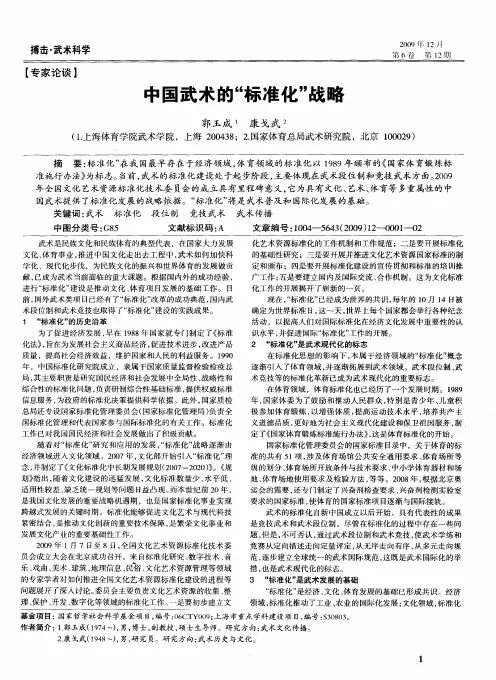
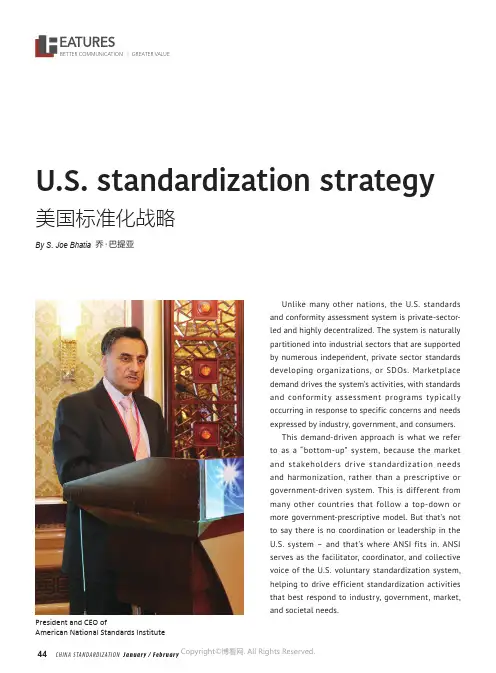
President and CEO ofAmerican National Standards Institute U.S. standardization strategyBy S. Joe Bhatia 乔·巴提亚美国标准化战略Unlike many other nations, the U.S. standards and conformity assessment system is private-sector-led and highly decentralized. The system is naturally partitioned into industrial sectors that are supported by numerous independent, private sector standards developing organizations, or SDOs. Marketplace demand drives the system’s activities, with standards and conformity assessment programs typically occurring in response to specific concerns and needs expressed by industry, government, and consumers.This demand-driven approach is what we refer to as a “bottom-up” system, because the market and stakeholders drive standardization needs and harmonization, rather than a prescriptive or government-driven system. This is different from many other countries that follow a top-down or more government-prescriptive model. But that’s not to say there is no coordination or leadership in the U.S. system – and that’s where ANSI fits in. ANSI serves as the facilitator, coordinator, and collective voice of the U.S. voluntary standardization system, helping to drive efficient standardization activities that best respond to industry, government, market,and societal needs.BETTER COMMUNICATION | GREATER VALUEThe U.S. standards system and strategyU.S. has a voluntary standards system, with broad representation and participation from industry, government, consumers, academia and others. And one of its essential components is a requirement for consensus-based decision-making in the standards development process. This approach, which is inclusive by design, offers flexibility, efficiency, and responsiveness, and maximizes opportunities for innovation and growth while addressing health and safety risks and enabling interoperability.The United States Standardization Strategy was created in recognition of the power of standardization. It is a guiding framework developed through coordinated efforts of a large and diverse group of constituents including stakeholders in government, industry, SDOs, consortia, consumer groups, and academia.The original strategy document, developed in 2000, was called the “National Standards Strategy,” but in 2005 it was updated and renamed the “U.S. Standards Strategy” --- reflecting the importance of globalization, and a standardization environment t h a t in co r p o r a t e s n e w t y p e s o f s t an dard s development activities, more flexible approaches, and new structures. ANSI leadership played a key role in developing the document as well as its recent updates, ensuring that the core principles remain the same while responding to major shifts in the U.S. and global economic landscapes.One of the most important aspects of the Strategy is its endorsement of the World Trade Organization (WTO) Technical Barriers to Trade (TBT) Agreement, which promotes cooperation and discourages the use standards as trade barriers. And to achieve this, the U.S. Standardization Strategy defines a need for the standards development process to be flexible, timely, and balanced. And more specifically, the strategy defines ninekey principles for standards development: transparency, openness, impartiality, effectiveness, relevance, consensus, performance-based, coherence, due process, and technical assistance.These principles and their reflection of the WTO TBT principles are what determine the relevance of a standard. And while ANSI acts as the coordinator of the U.S. system, we don’t prescribe one particular standards developer or type of developer – whether U.S.-based or internationally structured – for any scope of activity. Rather, the market decides, by determining which standard is most fit for purpose in any particular industry sector to move the technology forward, while complying with various public-safety mandates.BETTER COMMUNICATION | GREATER VALUEHow ANSI fits into the systemSince 1918 -- 100 years exactly -- ANSI has administered and coordinated voluntary standards and conformity assessment activities in the U.S., with the cooperation of the private sector and the federal, state and local governments, and we engage in standardization forums throughout the world as the U.S. National Standards Body. The Institute is a unique partnership of industry, professional, technical, trade, labor, academic, and consumer organizations, as well as government agencies. These members of the ANSI federation are the ones actually developing standards and conformity assessment programs, contributing their time and expertise in order to make the system work.There are currently 240 SDOs across a broad range of industry sectors that are accredited by ANSI to develop American National Standards. And there are now more than 12,000 ANSI-approved ANS that address topics as diverse as dimensions, ratings, terminology and symbols, test methods, interoperability criteria, product and system specifications, and performance and safety requirements.The Institute’s approval of a candidate standard or conformity assessment program as an ANS verifies that the principles of openness and due process have been followed and that a consensus of all interested parties has been reached. Due process requires that all proposed ANS be circulated to the public at large for comment, that an attempt be made to resolve all comments, and that there is a right of appeal. In addition, ANSI considers any evidence that a proposed ANS is contrary to the public interest, contains unfair provisions or is unsuitable for national use. This basic formula has been the hallmark of the ANS process for decades, and it has garnered worldwide respect and acceptance.One of the best indicators of confidence in the U.S. voluntary consensus standardization and conformity assessment system is Congress’s 1996 passage of the National Technology Transfer and Advancement Act, or NTTAA. This law requires federal agencies to use voluntary consensus standards and conformity assessment programs for regulatory purposes wherever feasible, and to procure equipment and services in accordance with such standards. It also requires agencies to increase their participation in the development process and directs the Commerce Department’s National Institute of Standards and Technology (NIST) to coordinate federal, state and local "voluntary standards and related conformity assessment activities."Within this diverse system, hundreds of standards developing organizations (SDOs) and consortia are engaged in the creation and maintenance of standards for virtually every industry sector, and often working cooperativelyand collaboratively on common objectives. Frontline experts from companies, labor, consumer and industrial organizations---and many representatives of government agencies at all levels--- voluntarily contribute their knowledge, talents, and efforts to standards-setting activities, working on the cutting edge of various technologies with a dedication to ensuring that broad and deep expertise is considered.The dynamic strength of the system is a reflection of its guiding principles, which assert that standards should meet societal and market needs and should not be developed to act as barriers to trade. Collabration with ChinaChina is an important export market for many U.S. companies which is why ANSI offers key information through a web standards portal that supports information exchange for American and Chinese companies. Market access and market acceptance requirements are a key element for export success. The portal is a communication platform that provides access to standards used in China, China’s laws and customs regulations, U.S. export regulations, an ever-expanding FAQ session, and more.You can find information about China and other export markets, information on the ANSI Manufacturer Member Roundtable in China, Delegation Visits to ANSI, the ANSI in China newsletter published quarterly in English and in Chinese, and other documents and resources related to international trade.ANSI recently began implementation of its 3rd contract under the USTDA funded, U.S.-China Standards and Conformity Assessment Cooperation Program (SCACP). The program calls for the implementation of 20 workshops in China over a 3-year period, covering a wide range of sectorial topics related to the standards, conformity assessment programs, and technical regulations that impact U.S. and Chinese industry. We have organized 4 out 20 workshops so far on topics related to green building materials, green lighting certification, smart and green hospitals, the global meat industry and ultra-sound education and certification.We will also be hosting SAC Administrator Mr. Tian Shihong in Washington DC in 2019 and organizing another executive roundtable on enterprise standards. We hope to have productive discussions and updates on the implementation of the revised Standardization Law. We lookforward to continuing an effective and cooperative future with China.。
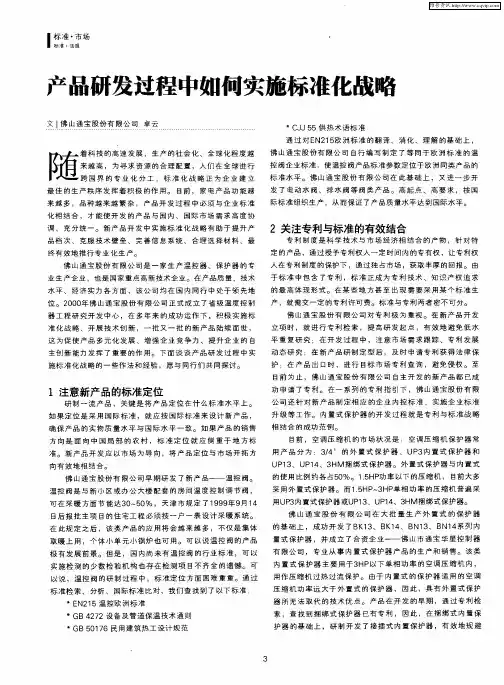
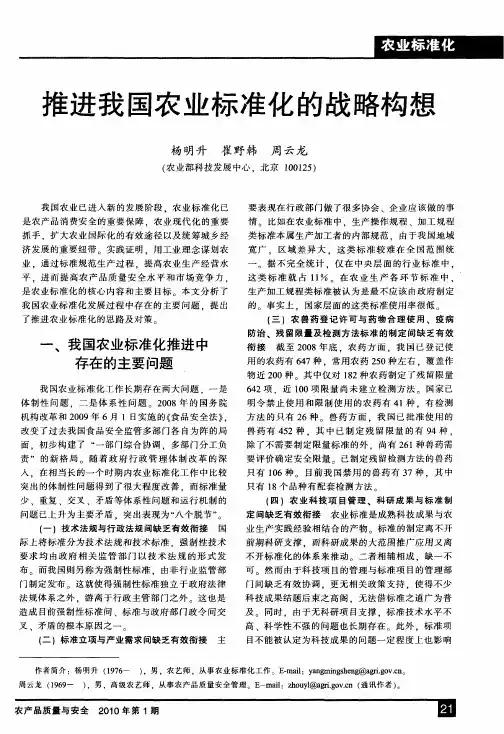

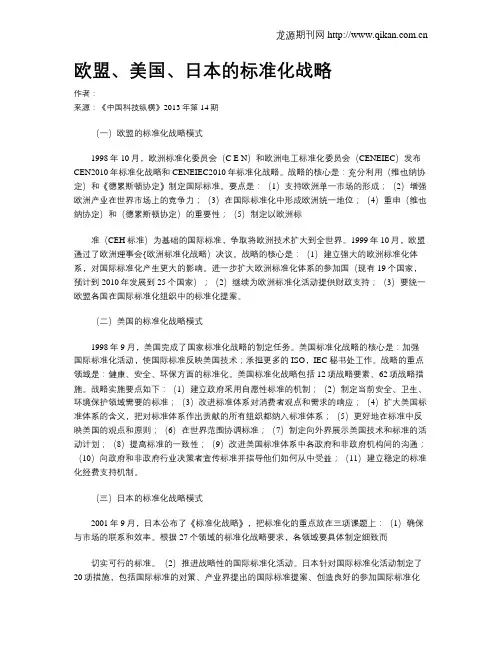
欧盟、美国、日本的标准化战略作者:来源:《中国科技纵横》2013年第14期(一)欧盟的标准化战略模式1998年10月,欧洲标准化委员会(C E N)和欧洲电工标准化委员会(CENEIEC)发布CEN2010年标准化战略和CENEIEC2010年标准化战略。
战略的核心是:充分利用(维也纳协定)和《德累斯顿协定》制定国际标准。
要点是:(1)支持欧洲单一市场的形成;(2)增强欧洲产业在世界市场上的竞争力;(3)在国际标准化中形成欧洲统一地位;(4)重申(维也纳协定)和(德累斯顿协定)的重要性;(5)制定以欧洲标准(CEH标准)为基础的国际标准,争取将欧洲技术扩大到全世界。
1999年10月,欧盟通过了欧洲理事会{欧洲标准化战略)决议。
战略的核心是:(1)建立强大的欧洲标准化体系,对国际标准化产生更大的影响。
进一步扩大欧洲标准化体系的参加国(现有19个国家,预计到2010年发展到25个国家);(2)继续为欧洲标准化活动提供财政支持;(3)要统一欧盟各国在国际标准化组织中的标准化提案。
(二)美国的标准化战略模式1998年9月,美国完成了国家标准化战略的制定任务。
美国标准化战略的核心是:加强国际标准化活动,使国际标准反映美国技术;承担更多的ISO,IEC秘书处工作。
战略的重点领域是:健康、安全、环保方面的标准化。
美国标准化战略包括12项战略要素、62项战略措施。
战略实施要点如下:(1)建立政府采用自愿性标准的机制;(2)制定当前安全、卫生、环境保护领域需要的标准;(3)改进标准体系对消费者观点和需求的响应;(4)扩大美国标准体系的含义,把对标准体系作出贡献的所有组织都纳入标准体系;(5)更好地在标准中反映美国的观点和原则;(6)在世界范围协调标准;(7)制定向外界展示美国技术和标准的活动计划;(8)提高标准的一致性;(9)改进美国标准体系中各政府和非政府机构间的沟通;(10)向政府和非政府行业决策者宣传标准并指导他们如何从中受益;(11)建立稳定的标准化经费支持机制。
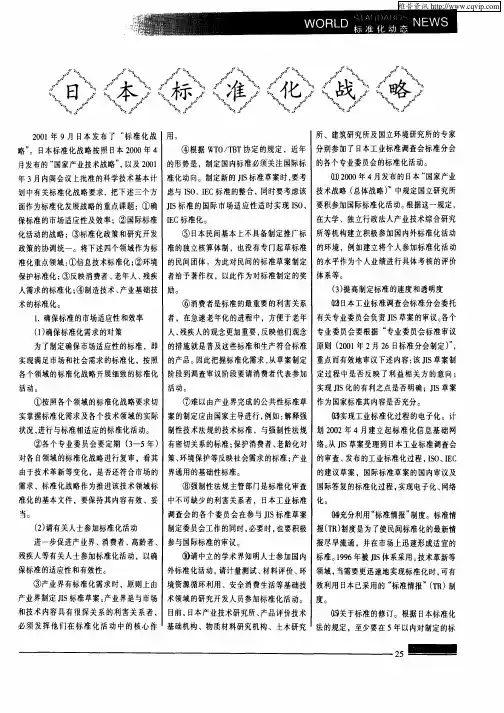
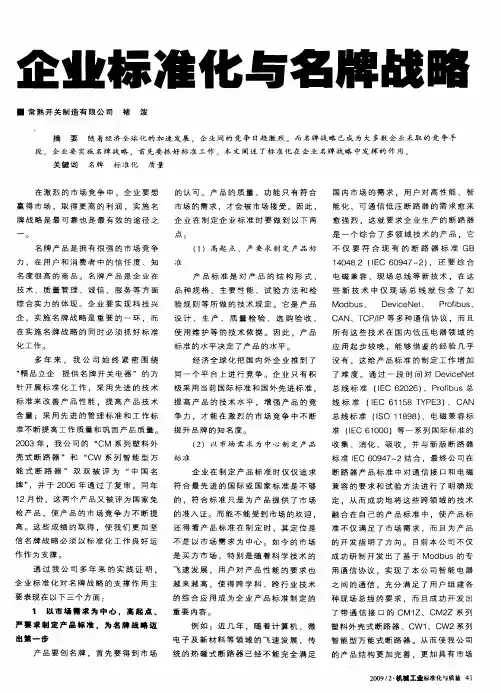
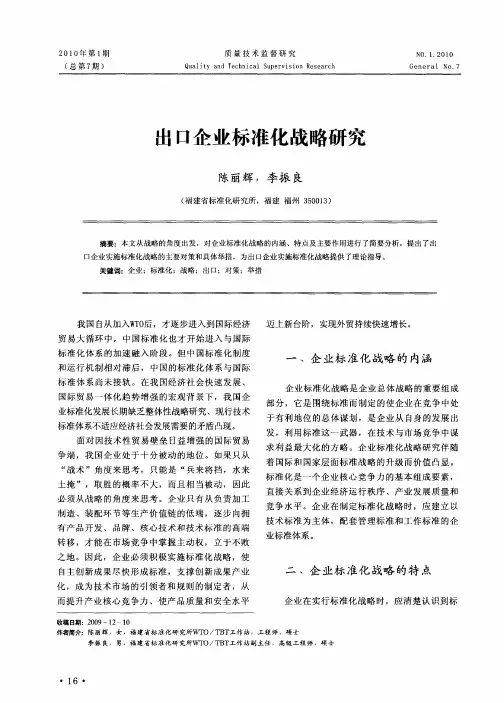
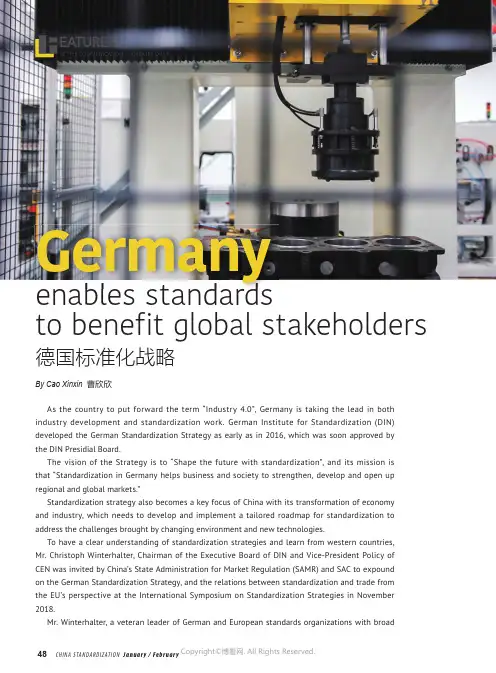
enables standards to benefit global stakeholders德国标准化战略As the country to put forward the term “Industry 4.0”, Germany is taking the lead in both industry development and standardization work. German Institute for Standardization (DIN) developed the German Standardization Strategy as early as in 2016, which was soon approved by the DIN Presidial Board.The vision of the Strategy is to “Shape the future with standardization”, and its mission is that “Standardization in Germany helps business and society to strengthen, develop and open up regional and global markets.”Standardization strategy also becomes a key focus of China with its transformation of economy and industry, which needs to develop and implement a tailored roadmap for standardization to address the challenges brought by changing environment and new technologies.To have a clear understanding of standardization strategies and learn from western countries, Mr. Christoph Winterhalter, Chairman of the Executive Board of DIN and Vice-President Policy of CEN was invited by China’s State Administration for Market Regulation (SAMR) and SAC to expound on the German Standardization Strategy, and the relations between standardization and trade from the EU’s perspective at the International Symposium on Standardization Strategies in November 2018.Mr. Winterhalter, a veteran leader of German and European standards organizations with broadBy Cao Xinxin 曹欣欣GermanyBETTER COMMUNICATION | GREATER VALUEvision and profound expertise, opened a brand new window of view for Chinese officials, experts and practitioners at the Symposium. In his keynote speech, Mr. Winterhalter started with the development process of the German Standardization Strategy, which was created with the joint efforts of all stakeholders from government, industry and society. Thus, the Strategy represents a long-term goal with the common consensus reached by the stakeholders.The Strategy is composed of six goals covering all aspects relevant to standards and standardization. It recognizes the irreplaceable importance of standardization for international and European trade, deregulation, industry, society, companies as well as the pubic and vice versa. Meanwhile, it emphasizes that standardization should be used as an important strategic instrument by government, industry and companies, and it can play a full role only when it is highly regarded by companies and the pubic.DIN and DKE (German Commisson for Electrical, Electronic & Information Technologies of DIN and VDE) are institutions recognized by policymakers, industry and society, which can make great contributions to industry’s global competitiveness. They also provide the world’s leading moderation platform for standardization.In the Strategy, DIN and DKE determine to work in close cooperation with technical associations, forums and consortia, maintain an open dialogue with the public, and use innovative participation processes to involve stakeholders, according to Mr. Winterhalter.More importantly, Mr. Winterhalter proposed recommendations to the Chinese government based on his understanding of the current situation of China’s standardization work. His penetrating judgement and profound insight were highly praised and accepted by the officials and experts at the event.In addition, he specifically analyzed the relations between standardization and trade from the EU’s perspective at the Panel on “Standards facilitating international trade”. On behalf of the European Committee for Standardization (CEN), Mr. Winterhalter spoke about how European standards facilitate businesses and trade. In his opinions, harmonization in Europe means one standardization solution instead of 34. And European standards can help reduce business transaction costs, improve customer recognition, and give access to world markets.He stressed that CEN and CENELEC make China, Africa, Gulf Region, Japan and India the five prioritized regions in this year’s plan. with which they want to build a long-term win-win partnership. They also want to cooperate with China on bringing new ideas to make the ISO-IEC system more effective, and work together to facilitate mutual understanding between Chinese and European experts.The highly perceptive views and comments of Mr. Winterhalter bring new ideas on how to better define and implement the Chinese standardization strategy. The experience of advanced standards organizations such as CEN and CENELEC and the expertise of global specialists will help China make a tailored strategic plan suitable for its own development, helping standards play a bigger role and making greater contributions to stakeholders across the globe.For more information, you can read the extract from the German Standardization Strategy which was approved by the DIN Presidial Board on November 3, 2016.The German Standardization StrategyVision: “Shape the future with standardization!”Goal 1: International and European trade is facilitated by standardization.Goal 2: Standardization is an instrument of deregulation.Goal 3: Germany is at the forefront in bringing future-oriented topics into standardization on a worldwide scale through the networking of stakeholders and the establishment of new processes and open platforms for coordination.Mission: “Standardization in Germany helps business and society to strengthen, develop and open up regional and global markets.”The international relevance of ISO and IEC is recognized and will continue to be reinforced.The European Internal Market is strengthened by standardization.The market relevance of standardization projects is ensured.DIN and DKE are institutions recognized by policymakers, industry and society as contributing to industry’s global competitiveness, and specifically to Germany’s global competitiveness, through standardization.Standards are an instrument of deregulation and facilitate public procurement. However, it is generally recognized that they are not an appropriate instrument to regulate what is subject solely to political will, the representation of public interests or is the domain of social partners.The New Legislative Framework is expanded to cover further appropriate areas, while maintaining the division of responsibilities between EU and member states.Standards setters and policy makers work together on a basis of mutual trust.The public interest is taken into account in standardization, in particular the safeguarding of protection targets such as environmental and consumer protection, occupational health and safety, health protection and building safety. Standards contribute to the global transfer of German sustainability benchmarks.DIN and DKE provide the world’s leading moderation platform for standardization. They organizestandardization topics and coordinate teamwork beyond the borders of their own organizations,including for fora and consortia and other standard development organizations.DIN and DKE are catalysts for digital transformation in the standards world.BETTER COMMUNICATION | GREATER VALUEGoal 4: Industry and society are the driving forces in standardization.Industry is a key pillar of standardization and demonstrates a high level of competence and enduring commitment. Industry is increasingly willing to make experts available for participation in national, European and international standards projects.Standardization topics are introduced in large part by industry.Goal 5: Standardization is used in particular by companies as an important strategic instrument. Industry recognizes the benefits of standardization at all levels of the company.Management uses standardization as a strategic tool to achieve corporate objectives; participation in standards committees is promoted and valued highly.Standardization work is appealing. Effective and reliable processes and structures have been established. Suitable digital tools are used.Standards are practical in application, limited to the essentials and a central source of information. Standards take the requirements of users into account. These requirements are a quality benchmark for standardization. A modular standards structure is established.The targeted involvement of experts from SMEs is made possible.The technical associations and the institutional leaders of German standardization, DIN and DKE, together with the Federal Government, encourage companies to use standardization in both their domestic and export businesses.Goal 6: Standardization is highly regarded by the public.Standards represent safety and quality.The processes of standardization are e ff icient and are perceived as such.The public is involved in standardization through clear structures and transparent processes.DIN and DKE maintain an open and transparent dialogue with the public, also using innovative participation processes to involve stakeholders.The quality assurance of the standardization process is transparent.Standardization has become increasingly anchored in vocational training and academia. Discussions are taking place on an ongoing basis regarding the role of standardization in its relationship with science and technology, industry, politics and society and societal transformation in all areas.The benefits of standardization and its contribution to economic activity, to the public good and sociopolitical protection targets like environmental and consumer protection, occupational health and safety, health protection and building safety have been communicated and acknowledged.(Source: DIN)。
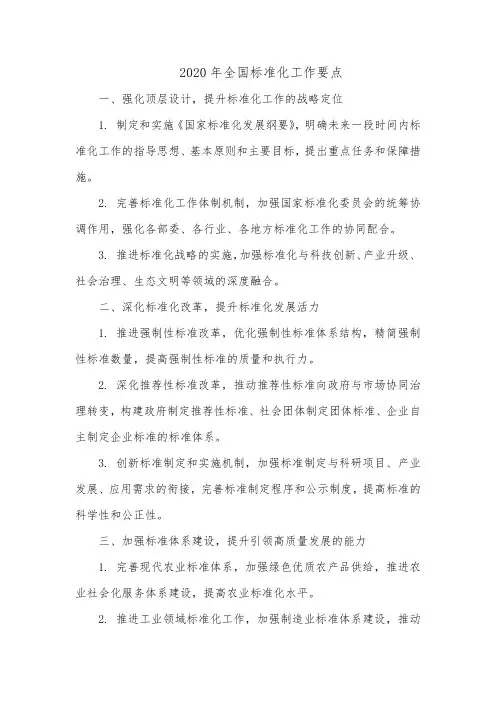
2020年全国标准化工作要点一、强化顶层设计,提升标准化工作的战略定位1. 制定和实施《国家标准化发展纲要》,明确未来一段时间内标准化工作的指导思想、基本原则和主要目标,提出重点任务和保障措施。
2. 完善标准化工作体制机制,加强国家标准化委员会的统筹协调作用,强化各部委、各行业、各地方标准化工作的协同配合。
3. 推进标准化战略的实施,加强标准化与科技创新、产业升级、社会治理、生态文明等领域的深度融合。
二、深化标准化改革,提升标准化发展活力1. 推进强制性标准改革,优化强制性标准体系结构,精简强制性标准数量,提高强制性标准的质量和执行力。
2. 深化推荐性标准改革,推动推荐性标准向政府与市场协同治理转变,构建政府制定推荐性标准、社会团体制定团体标准、企业自主制定企业标准的标准体系。
3. 创新标准制定和实施机制,加强标准制定与科研项目、产业发展、应用需求的衔接,完善标准制定程序和公示制度,提高标准的科学性和公正性。
三、加强标准体系建设,提升引领高质量发展的能力1. 完善现代农业标准体系,加强绿色优质农产品供给,推进农业社会化服务体系建设,提高农业标准化水平。
2. 推进工业领域标准化工作,加强制造业标准体系建设,推动智能制造、绿色制造等领域标准研制和应用,提高工业标准化水平。
3. 加强服务业标准体系建设,推动电子商务、金融保险、旅游休闲等领域标准研制和应用,提高服务业标准化水平。
4. 推进新兴产业标准体系建设,加强数字经济、智能制造、新能源等领域标准研制和应用,推动新产业、新业态、新模式的发展。
四、参与国际标准治理,提升标准国际化水平1. 加强国际标准化合作与交流,积极参与国际标准制定和修订工作,提高我国在国际标准化领域的话语权和影响力。
2. 推动我国标准“走出去”,加强与“一带一路”沿线国家和地区的标准化合作,推动我国标准在海外市场的应用和推广。
3. 积极参与国际标准治理体系的改革和建设,加强我国在国际标准化组织中的参与和领导力。
国内外标准化战略分析及其发展方向关于《国内外标准化战略分析及其发展方向》,是我们特意为大家整理的,希望对大家有所帮助。
前言随着经济发展的全球化,技术交流经、济交往,打破了原有的疆界,形成了全球范围的大生产和大流通,因而全球化经济发展浪潮把标准化推上了战略地位。
技术标准既可以成为促进国际经济交流的催化剂,又可以成为人为设置的贸易壁垒,得标准者得天下,谁掌握了标准,谁就在本行业中拥有“话语权”。
1 背景随着标准在国际贸易中的作用越来越重要,主要发达国家纷纷把争夺和主导国际标准作为国际经济竞争的首选策略。
发达国家在相关国际机构中争夺国际标准的起草权、参与权和领导权的竞争也随之展开,其白热化程度同商品市场相比毫不逊色。
融入经济全球化,中国面临着更加严峻的竞争,中国只有从仅负责加工制造、装配环节等全球生产价值链的低端逐步向拥有产品开发、品牌、核心技术、标准等高端环节转移,才能在全球竞争中掌握主动。
因此,必须鼓励创新,掌握核心技术,注重制定具有自主知识产权的标准,采取标准化战略,将核心技术、知识产权、标准进行有机的结合,充分发挥组合效应,建立自主的国家创新体系,从而实现产业和经济的跨越式发展。
【表1】2 国外分析2.1 主要发达国家标准化战略终极目标是实现本国经济利益最大化主要发达国家之所以把争夺国际标准制高点作为战略核心,是因为控制和争夺国际标准可以为本国带来很大的经济效益。
标准化每年为德国带来160 亿欧元的经济效益,约占国民生产总值的1%,标准化对经济的贡献率为 2.7%,是专利对经济贡献率的9 倍。
2.2 将国际标准化战略放在整个标准化发展战略的突出位置,积极参与国际标准化以英、法、德为主的西欧国家一直将很多精力和时间放在国际和区域标准化活动上,企图长期控制国际标准化的技术大权,并且不遗余力地把本国标准变成国际标准。
2.3 争夺国际标准主导权成为欧、美、日等发达国家的战略选择发达国家千方百计地在国际标准化活动中争取主动权、发言权,并竭力在国际标准中反映本国的要求,体现本国利益,千方百计地争夺制定国际标准的主导权。
试论我国无公害农产品标准化的发展战略[摘要]农产品标准化是“三品一标”品牌持续健康发展的基础,也是农产品质量安全建设和现代农业发展的必然要求。
目前,农业标准普及率低,投入与监管不严,产品质量难追溯,仍然是农业标准化需要解决的突出问题。
本文在研究了无公害农产品标准化相关理论和实践的基础上,简要分析了我国未来无公害农产品标准化的发展战略。
[关键词]无公害农产品标准化发展战略农业标准化是现代农业的标志之一,是提高农产品质量安全的重要措施。
各地要高度重视,积极扩大农业标准化示范,推动农业标准化进程。
全国各级农业部门要站在农产品质量安全的高度,按照农业部关于扩大农业标准化示范的有关精神,统筹“米袋子”、“菜篮子”、“油罐子”、“果盘子”项目,加强领导,加强宣传,落实措施,加快推进。
一、无公害农产品安全品牌的树立首先,将无公害农产品标准化发展同农业产业化发展相结合。
标准化、产业化以及市场化已经成为实现农业现代化的基本途径。
农产品的标准化生产要同我国农业产业化发展的大方向保持一致,以产业发展为基础,按照相关标准对产地环境、条件以及生产过程、质量等进行严格要求,积极对农户进行技术指导,将标准化生产技术全面贯彻到实际生产中。
坚持走产业化经营之路,有效提高农业生产的组织化水平以及社会化服务能力,加强企业和农合之间的利益联系,争取实现农业现代化。
其次,要严格按照法律法规的要求,稳步推进无公害农产品的标准化发展。
随着《农产品质量安全法》以及相关法律法规的出台,我国政府进一步表明了对无公害产品标准化发展的态度,并确认了其法律地位。
各级农业相关部门要充分利用政府用法律营造的有利政策氛围和工作环境,严格按照法律法规的要求,把无公害农产品标准化发展上升到法律建设的高度,依法对其进行监管,进一步推动无公害农产品标准化生产的发展。
二、无公害农产品标准化的全面实施首先,构建标准化生产的主体,全面引领无公害农产品标准化的迅速发展。
在以农户个体生产的背景下,企业和农户之间的专业化合作组织已经成为实现无公害农产品标准化发展的重要媒介和载体。
新疆维吾尔自治区人民政府关于印发《新疆维吾尔自治区标准化发展战略纲要(2011—2020年)》的通知文章属性•【制定机关】新疆维吾尔自治区人民政府•【公布日期】2013.02.18•【字号】新政发[2013]19号•【施行日期】2013.02.18•【效力等级】地方规范性文件•【时效性】现行有效•【主题分类】民族区域自治正文新疆维吾尔自治区人民政府关于印发《新疆维吾尔自治区标准化发展战略纲要(2011—2020年)》的通知(新政发〔2013〕19号)伊犁哈萨克自治州,各州、市、县(市)人民政府,各行政公署,自治区人民政府各部门、各直属机构:《新疆维吾尔自治区标准化发展战略纲要(2011-2020年)》已经自治区第十一届人民政府第36次常务会议研究通过,现印发给你们,请认真贯彻执行。
2013年2月18日新疆维吾尔自治区标准化发展战略纲要(2011-2020年)标准化是国民经济和社会可持续发展的重要技术支撑。
近年来,在自治区党委、自治区人民政府的正确领导下,我区把标准化工作作为“质量兴新”、促进经济社会又好又快发展的重要基础工作来抓,认真贯彻实施《中华人民共和国标准化法》,积极开展各项标准化工作,在农业、工业和服务业标准化领域取得明显成效。
目前,我区已初步建立覆盖优势特色农产品的标准体系和农业标准化示范区,工业企业标准化从制订单一产品标准向建立标准体系拓展和完善,服务业标准化工作逐步推进和完善。
但总体而言,我区标准化工作水平还不高,公众的标准化意识尚待加强,企业技术标准创新能力较弱,科技创新与技术标准缺乏有机结合,体制机制还不完善,标准体系不健全,我区标准化工作与全区经济社会发展水平还不相适应。
实施标准化发展战略,有利于促进技术进步和科技成果转化,充分发挥标准化的技术支撑作用;有利于企业通过对标准的有效利用,提高管理水平、产品质量和安全水平;有利于推动产业结构调整和优化升级,加快新型工业化、农牧业现代化、新型城镇化进程,提升全区特色优势产业和战略性新兴产业的核心竞争力;有利于科学合理有效利用优势资源,发展生态文明,建设资源节约型和环境友好型社会,推进新疆科学跨越发展。